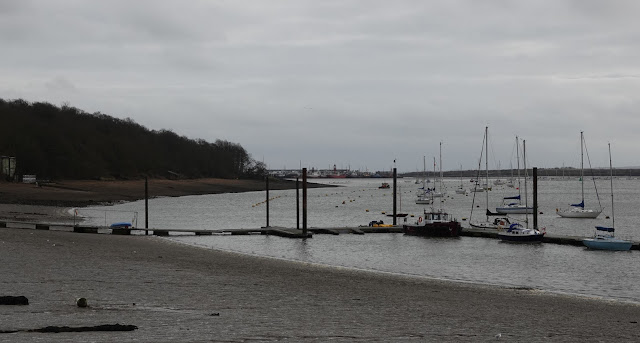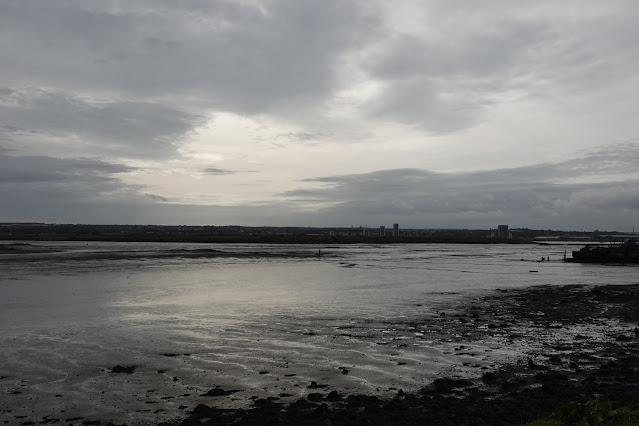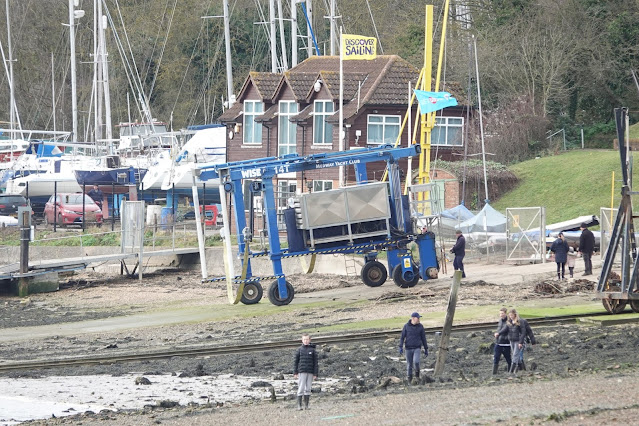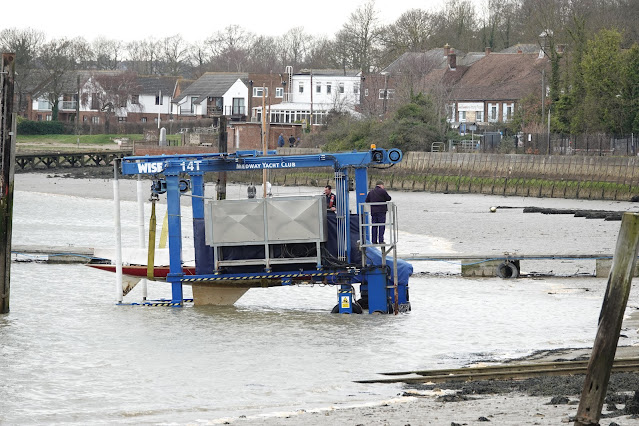It has been a funny sort of week with the underlying stress of
car and cat troubles but I was determined to head out on a walk somewhere
today. The forecast was grey and breezy
but mild and dry so I opted for the Hoo route to at least give me a chance of
seeing a few estuarine species.
I wiggled through town and up to Frindsbury All Saints
(avoiding Donkey Hill) and found the wind to be hardly Saharan in temperature
as it whipped over the cliff top.
Blackbirds, Robins and Woodpigeons were all feeding in the deck on the
shelter of the Ivy hedge.
They had already inexplicably mowed quite a large are of the
oldest part of the cemetery but I still found several clumps of Snowdrops and
Primroses and the odd little Luffia lapidella Bagworm moth cocoons were still
clustered on their chosen gravestone.
 |
Luffia lapidella in all the nooks and crannies!
|
 |
| Primroses |
 |
| Snowdrops |
There was only one Redwing on the walk down the lane and the
Cotoneaster and Ivy had been stripped almost to the last berry.
 |
Dog Violet I think
|
I crossed towards the Temple Hill STW were a
cloud of Pied Wagtails and Black-headed Gulls came up but once again Gundolph
Pool was devoid of life. Just beyond the
MoD entrance I found some small Holm Oaks and once again found moth leaf mines
and these appear to be Ectodemia heringella although I still have a lot to
learn.
 |
| Ectodemia heringella |
 |
| Ectodemia heringella |
 |
Ectodemia heringella - this one threw me as both mines looked really different
|
I popped into and empty Coelho’s for a pastry and kept
going. The tide was low and dropping fast which meant that I would get along the
beach but that once again the birds would be miles away – nevermind.
 |
Sooooooo grey
|
There were a lot more people around than normal and whereas
I would normally see a couple of hardy souls traipsing through the mud, today
there were loads of families and dog walkers out. It was easy enough to avoid people though – especially
with my wellies on. It was very grey and there were no birds on the foreshore
at all but I did find a Shag jump diving mid river with three Cormorants which
was pleasing. I presume it fancied a
change from Basin II of Chatham Maritime opposite.
As I approached Hoo Marina a flight of Brents whiffled in
and I suspected that they had been on the winter wheat in the field up behind
the woods. They alighted on the mud and
set about preening with a few Shelduck, Oystercatchers and Curlews for
company. There were only a couple of
Redshanks and just six Avocet to be seen.
 |
Dark-bellied Brent Geese
|
 |
The Phoenix out servicing mooring buoys
|
A small Harrier appeared over Hoo Saltmarsh (the Pampas
covered island) and I thought I had got myself a ringtail Hen as it was so
light and buoyant but the appalling light was not helping. It dropped lower and
against the tall grasses it was clearly all dark and therefore a young male
Marsh. Amazingly this was the first one I have seen on a walk with only an over
the house spring male making it onto the list.
I plodded through the Marina and utilized the shelter
provided to sit and have a cuppa while the Sparrows chattered around me and I
was glad that I did as once up on the river wall the wind was now seriously
gusting and had dropped the temperature considerably too. I walked all the way up to the gate
overlooking the marsh before Kingsnorth which was very hard going in places
with the thick clay rich mud weighing down my boots. The tide was miles out by now but I had taken
my MMIII out with me and by resting in one of the old MoD defences I was able
to spend some tome scanning the channels while I had my lunch. I was hoping for
Mergansers once again but only found a couple of Great Crested Grebes while
small groups of Brents, Pintail and Wigeon hunkered down in the margins. The odd Grey Plover was out on the mud but it
was hard going and even the game crop behind held nothing bar a couple of
Greenfinches this time.
 |
Pintail and a Curlew
|
My scans did add another new species though with a female
Merlin skipping low over the main channel as it made a b-line for Horrid Hill
while a Kestrel was hovering much closer on my side.
The view from the end gate showed me that most of the Brent
were infact out on the water meadows grazing with some Canadas and Greylags and
a few duck. I scanned them as best I could
but could not find a Black Brant this time.
My time with these birds was short lived as two chaps with a Lab and a
Spaniel set about doing some gun dog training on a whistle right in the middle
of the only bit of marsh around here that actually holds any birds inside the
seawall. The fact that they put up a
Jack Snipe did not reduce my frustration.
Apologies to those I know that responsibly train such dogs but this
really was completely unnecessary and pushed everything back out onto the now
lifeless mudflats. They tried to return but were constantly spooked.
 |
| Brents |
 |
Post Jack Snipe flush!
|
A flock of Lapwings appeared from further inland and
fluttered into the wind out onto the estuary – I would have used the word
shimmered but there was not enough light for that!
 |
| Lapwings |
 |
This was no Pony!
|
My fingers were frozen by this point but the idea of an
inland slog back did not appeal as I suspect that I would have seen very little
in the wind so I unusually decided to basically retrace my muddy step
homewards. It is odd how a path walked
in the other direction offers different viewpoints and opportunities.
Somehow I had not noticed the houseboat with the Plexiglass
Dome! Who knew that it was a real thing!
I grew up with Dr Seuss, and the Sleep Book in particular and...
‘On a mountain, halfway between Reno and Rome
We have a machine in a plexiglass dome
Which listens and looks into everyone’s home.
And whenever it sees a new sleeper go flop
It jiggles and lets a new Biggel-Ball drop.’
 |
This ship's dog was rather substantial - look at those legs!
|
The Brent flock that I suspected on the way out was indeed
in the wheat field but was soon on the move again and circling back into the
bay just beyond the Marina and an immature female Peregrine hurtled through. The tide was
coming in quite fast but I had plenty of time to make it along the beaches back
to Upnor only stopping to take some pictures of the Cockles, Clams (I think
they are non-native), Slipper Limpets (also a ballast stowaway) Oysters and Common Periwinkles
as well as a very fine thick bottle base with what I think is a stylised boar’s
head on it. If anyone has any idea of its
origins please let me know.
 |
One for the Seaweed experts out there!
|
 |
| Brents |
 |
The old Fort
|
 |
Common Periwinkle
|
 |
| Cockle |
 |
Slipper Limpet
|
 |
| Oyster |
 |
Clam sp
|
 |
| Clam sp |
 |
David Bradnum wins the prize for correctly identifying it as a 1920's Gordon's Gin Bottle!
|
 |
I also found several small pieces of clay pipe stem
|
 |
Great Crested Grebe
|
 |
Upnor castle
|
At the last boat ramp a curious beast emerged and slowly
trundled down into the river where a small dingy was ferried into its embrace before
being lifted on strops clear of the water and brought ashore for some maintenance.
It was heaving with people on the Upnor river frontage and
it is strange that this should now make me feel so uneasy. I have been so used to having most places pretty
much to myself that to suddenly see so many small groups of ‘humans’ was
somewhat un-nerving. I am not sure what
has changed over the last few days but despite there being no change in the
rules and guidelines there are certainly more people driving out for a walk
regardless of the day or weather. I just
hope that the genuine improvement in the figures around Medway do not slip
because of people thinking that it is all ok now.
I cut back past Coelho’s which had a throng waiting outside
and hurried up the steps and back towards the castle. I took the back path
through Temple Hill and was greeted almost immediately by a calling Firecrest
that then started singing. A second bird was in with it and like my other’s
recently the male was really going for it and sang persistently once he got
going. I could still hear him 50 yards
down the track after I moved off! There seems
to be quite a few locally this winter and some of those are in known breeding
spots and it will be interesting to see how many I can find this spring.
 |
| Firecrest |
A Chiffchaff called stridently from the ivy and Long-tailed
Tits moved through but all the Redwings had gone from the woods. I crossed the
main road and headed back up to All Saints before a rapid decent of Donkey Hill
back to the river and the final stretch towards home.
 |
Down Donkey Hill!
|





























































No comments:
Post a Comment